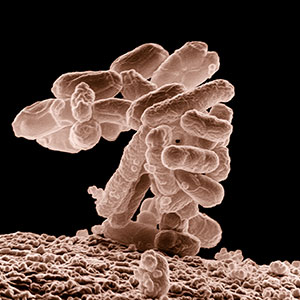Are you living the rural life in Alberta and worried about coliform bacteria in well water? You should be.
Research shows that total coliform, including E.coli, is present in 16.1% of private water wells in Alberta. Is yours one of them?
Recently, back in Dec of 2014, Parkland County, Leduc and Sturgeon County residents using well water were advised by Alberta Health Services to avoid drinking their water due to other sources of contamination.
Take action against these bacteria to protect your family and pets from serious illnesses.

E-Coli Bacteria
What Are Coliform Bacteria?
Coliform are rod-shaped organisms found in surface water, soil, plants and in the intestines of animals.
There are 3 types:
- total
- faecal
- E.coli.
Most of these organisms are harmless although some types of E.coli can cause diarrhea and vomiting. However, the presence of coliform bacteria in well water often indicates faecal contamination.
Faecal contamination is the major source of worm eggs and disease-carrying protozoa and viruses, such as those responsible for polio, dysentery, and hepatitis.
If bacteria can get into your drinking water, so can nasty bugs.
For safety’s sake is critical that you get rid of all forms of coliform bacteria in your well water so your family can enjoy the benefits of clean, pure drinking water.
Testing the Water from Your Well
Health Canada recommends that you test your water for microbiological contamination at least once a year. This can be done via your local health unit.
The process is simple. You will be given a sterilized sample bottle and told how to use it.
The water is then sent to a laboratory for testing. If coliform bacteria show up, further tests will be done to find out what type they are. Once you receive the results, it is up to you to eliminate all of these bugs from your water system.
Getting Rid of Organisms in Your Well Water
Keeping your well water free of bacteria is an ongoing process in rural environments. Agricultural activities can introduce microbiological components into the water due to incorrect management of fertilizers and pesticides.
Rainy weather can also contribute to increased bacteria levels.
The most common way to get rid of life forms in water is by using chlorine. Unfortunately, this method is expensive, maintenance-heavy, and comes with it’s own set of problems.
There are several other ways you can ensure a regular supply of safe, healthy drinking water for your household. These are:
Ultra-Violet Light Treatment
This is an expensive solution that does not eliminate contamination of water after it has been passed out of the treatment system and into your taps. It is not suitable for high bacteria counts.
Boiling
Boiling is a fail-safe way to ensure germ-free water. Who has time to boil all their drinking water though?
Reverse Osmosis
Reverse Osmosis is great for removing unwanted substances from your water in an urban setting. It is simply not designed for use with wells though.
What Is the Solution?
A water distiller is by far the most suitable option for getting the best out of your water well. Installation and maintenance are quick and easy and the units are available in a range of capacities to suit your family.
Give us a call today to discuss the ideal solution for your household.
By Photo by Eric Erbe, digital colorization by Christopher Pooley, both of USDA, ARS, EMU. – This image was released by the Agricultural Research Service, the research agency of the United States Department of Agriculture, with the ID K11077-1 (next).This tag does not indicate the copyright status of the attached work. A normal copyright tag is still required. See Commons:Licensing for more information., Public Domain, Link


Leave a Reply